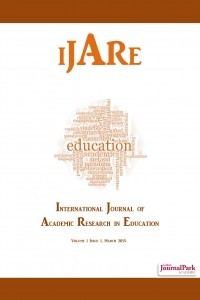A Systematic Literature Review: Constructivism in Multidisciplinary Learning Environments
A Systematic Literature Review: Constructivism in Multidisciplinary Learning Environments
This study represents a review of literature on constructivism used in multidisciplinary learning environments which is to uncover the usage rate of constructivism in multidisciplinary environments and to be a guide to those who are seeking further knowledge about this topic in the future. Aspects like publication date and learner categories were taken into consideration during the research. It includes the definition of constructivism, the usage progress of constructivism in the classroom through the years, the best age range which can easily adapt the constructivist approach, types of activities, and the advantages and disadvantages of the approach in the multidisciplinary classroom. 64 articles were surveyed and 30 articles were selected to analyze. The data obtained showed that there is a significant increase in using a constructivist approach in every kind of classroom. However, some of the articles revealed that there are also a small number of disadvantages, too.
Keywords:
constructivism, multidisciplinary, education, technology, stem learning environments,
___
- Ah-Nam, L., & Osman, K. (2017). Developing 21st Century Skills through a Constructivist- Constructionist Learning Environment. K-12 STEM Education, 3(2), 205-216.
- Akar, H., & Yıldırım, A. (2005). Challenges of introducing a constructivist classroom culture in a predominantly teacher-centered environment.
- Akçayır, M., & Akçayır, G. (2017). Advantages and challenges associated with augmented reality for education: A systematic review of the literature. Educational Research Review, 20, 1-11.
- Amineh, R. J., & Asl, H. D. (2015). Review of constructivism and social constructivism. Journal of Social Sciences, Literature, and Languages, 1(1), 9-16.
- Basturk, S. (2016). Primary Pre-Service Teachers' Perspectives on Constructivism and Its Implementation in the Schools. Universal Journal of Educational Research, 4(4), 904- 912.
- Dewi, I., & Harahap, M. S. (2016). The Development of Geometri Teaching Materials Based on Constructivism to Improve the Students' Mathematics Reasoning Ability through Cooperative Learning Jigsaw at the Class VIII of SMP Negeri 3 Padangsidimpuan. Journal of Education and Practice, 7(29), 68-82.
- Driscoll, M. P. (2005). Psychology of learning for instruction.
- Gijbels, D., Van De Watering, G., Dochy, F., & Van Den Bossche, P. (2006). New learning environments and constructivism: The students’ perspective. Instructional Science, 34(3), 213-226.
- Glancy, A. W., & Moore, T. J. (2013). Theoretical foundations for effective STEM learning environments.
- Gomleksiz, M. N., & Elaldi, Ş. (2011). Yapılandırmacı Yaklaşım Bağlamında Yabancı Dil Öğretimi. Electronic Turkish Studies, 6(2).
- Gordon, M. (2009). Toward a pragmatic discourse of constructivism: Reflections on lessons from practice. Educational studies, 45(1), 39-58.
- Gunduz, N., & Hursen, C. (2015). Constructivism in Teaching and Learning; Content Analysis Evaluation. Procedia-Social and Behavioral Sciences, 191, 526-533.
- Hartle, R. T., Baviskar, S., & Smith, R. (2012). A Field Guide to Constructivism in the College Science Classroom: Four Essential Criteria and a Guide to their Usage. Bioscene: Journal of College Biology Teaching, 38(2), 31-35.
- Hendry, A., Hays, G., Challinor, K., & Lynch, D. (2017). Undertaking Educational Research Following the Introduction, Implementation, Evolution, and Hybridization of Constructivist Instructional Models in an Australian PBL High School. Interdisciplinary Journal of Problem-Based Learning, 11(2), 7.
- Jaleel, S., & Verghis, A. M. (2015). Knowledge creation in constructivist learning. Universal Journal of Educational Research, 3(1), 8-12.
- Kamphorst, J. C. (2018). Multidisciplinary Cooperation by Students in a European University of Applied Sciences. Journal of University Teaching and Learning Practice, 15(1), 5.
- Khuzzan, S. M. S., Goulding, J. S., & Rahimian, F. P. (2015). Purposive teaching styles for transdisciplinary AEC education: A diagnostic learning styles questionnaire. International Journal of Architectural Research: ArchNet-IJAR, 9(2), 98-112.
- Krahenbuhl, K. S. (2016). Student-centered education and constructivism: Challenges, concerns, and clarity for teachers. The Clearing House: A Journal of Educational Strategies, Issues, and Ideas, 89(3), 97-105.
- Lash, M. (2008). Classroom community and peer culture in kindergarten. Early Childhood Education Journal, 36(1), 33-38.
- Le Cornu, R., & Peters, J. (2009). Towards constructivist classrooms: the role of the reflective teacher. The Journal of Educational Enquiry, 6(1).
- Liu, C. C., & Chen, I. J. (2010). Evolution of constructivism. Contemporary issues in education research, 3(4), 63-66.
- Marlow, M. P., & McLain, B. (2011). Assessing the Impacts of Experiential Learning on Teacher Classroom Practice. Research in Higher Education Journal, 14.
- Mayer, M. M. (2006). The effect of constructivist learning environments on student learning in an undergraduate art appreciation course (Doctoral dissertation, University of North Texas).
- Mvududu, N. H., & Thiel-Burgess, J. (2012). Constructivism in practice: The case for English language learners. International Journal of Education, 4(3), 108-118.
- Prensky, M. (2003). Digital game-based learning. Computers in Entertainment (CIE), 1(1), 21- 21.
- Savery, J. R., & Duffy, T. M. (1995). Problem-based learning: An instructional model and its constructivist framework. Educational technology, 35(5), 31-38.
- Shively, J. (2015). Constructivism in music education. Arts Education Policy Review, 116(3), 128-136.
- Steakley, M. E. (2008). Advantages, Disadvantages, and Applications of Constructivism.
- Thompson, C. M. (2015). Constructivism in the art classroom: Praxis and policy. Arts Education Policy Review, 116(3), 118-127.
- Thompson, Penny. (2018). Foundations of educational technology.
- Yayın Aralığı: Yıllık
- Başlangıç: 2015
- Yayıncı: Süleyman Nihat ŞAD
Sayıdaki Diğer Makaleler
Burak AYÇİÇEK, Tuğba YANPAR YELKEN
Hülya GÜLAY OGELMAN, Hatice ERTEN SARIKAYA, Hande GÜNGÖR, Özlem KÖRÜKÇÜ
An Interview with Keith E. Wittington: Free Speech, Hate Speech and the University
A Systematic Literature Review: Constructivism in Multidisciplinary Learning Environments
